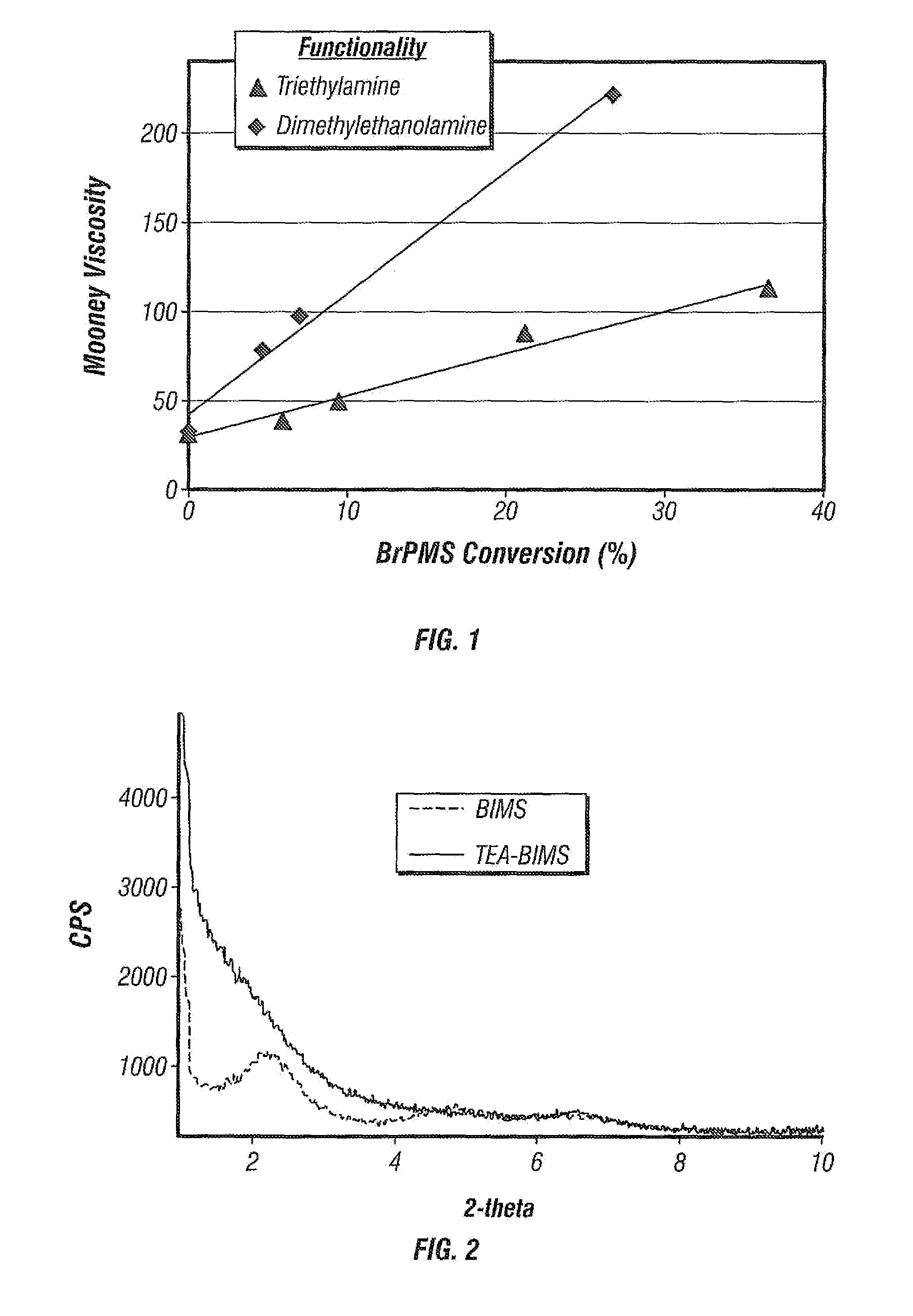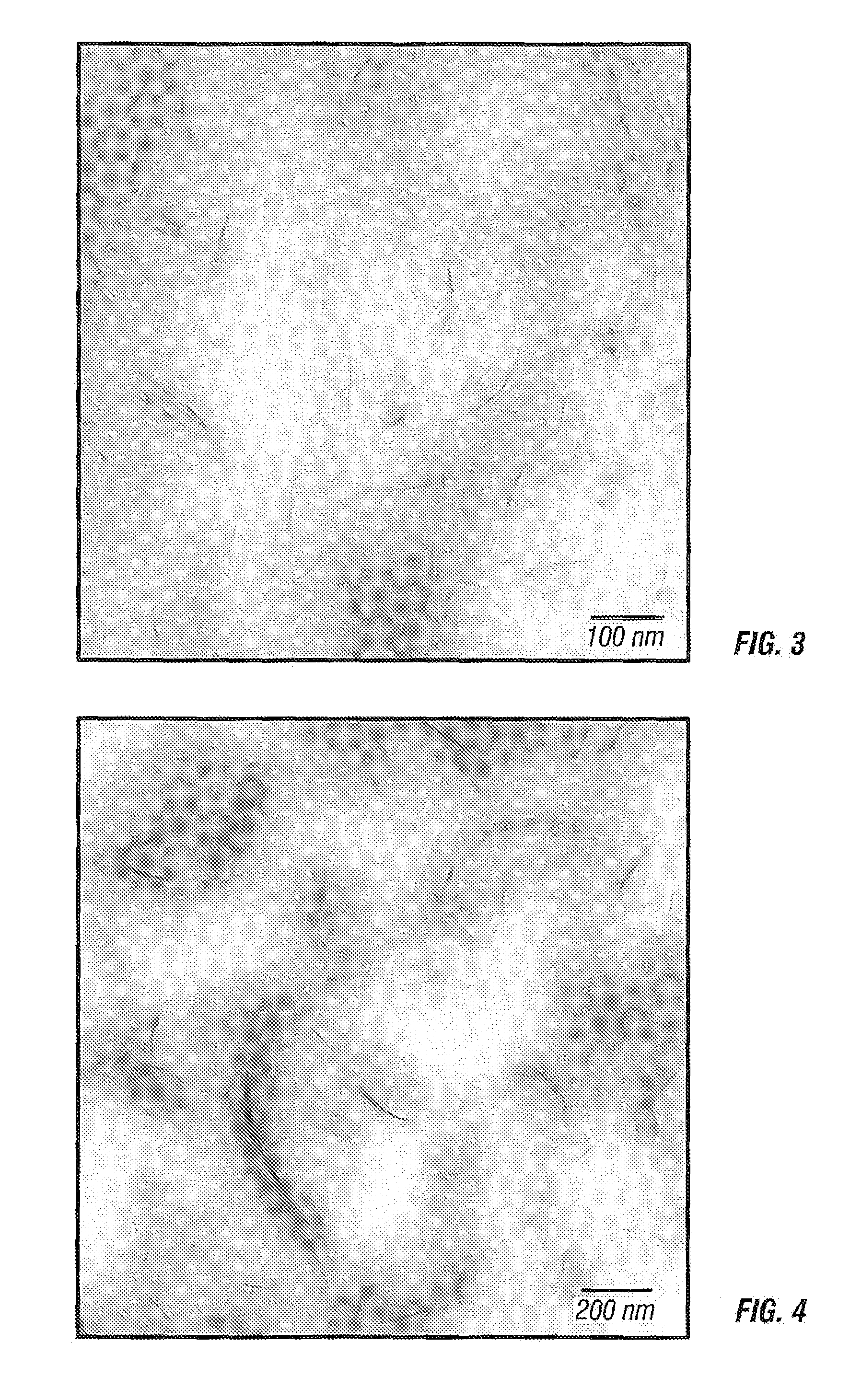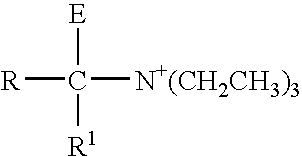Triethylamine Functionalized Elastomer in Barrier Applications
a technology of functionalized elastomers and elastomers, which is applied in the field of low-permeability elastomers, can solve the problems of difficult to achieve a good clay dispersion or exfoliation in the elastomer, and the viscosity of the polymer can increase significantly
- Summary
- Abstract
- Description
- Claims
- Application Information
AI Technical Summary
Benefits of technology
Problems solved by technology
Method used
Image
Examples
example 1
Comparative—100-TEA-BIMS
[0104]Fifty grams of EXXPRO™ brominated isobutylene-para-methylstyrene copolymer (BIMS) (MDX 03-1: 10 wt % para-methylstyrene (PMS), 0.85 mol % BrPMS, Mooney 31.5) were dissolved in 500 mL of toluene in a 1-L reactor. Triethylamine (TEA) (4.38 g) was dissolved in 150 mL of isopropyl alcohol and added to the reactor. The reaction mixture was heated to 85-86° C. and refluxed for 6 hours. The product was precipitated by adding 1000 mL of isopropyl alcohol to the polymer cement. After drying in a vacuum oven at 80° C. for 16 hours, the 1H NMR analysis of the precipitate showed complete or substantially 100% conversion of benzylic bromide to ammonium functionality in the resulting functional polymer (100-TEA-BIMS).
example 2
36-TEA-BIMS
[0105]One hundred grams of EXXPRO™ BIMS polymer (MDX 03-1: 10 wt % of PMS, 0.85 mol % BrPMS, Mooney 31.5) were dissolved in 750 mL of toluene in a 2-L reactor. TEA (1.46 g) was dissolved in 150 mL of isopropyl alcohol and added to the reactor. The reaction mixture was heated to 85-86° C. and refluxed for 6 hours. The product was precipitated by adding 1000 mL of isopropyl alcohol to the polymer cement. After drying in a vacuum oven at 80° C. for 16 hours, the 1H NMR analysis of the precipitate showed 36.5% conversion of benzylic bromide to ammonium in the resulting functional polymer (36-TEA-BIMS).
example 3
21-TEA-BIMS
[0106]One hundred grams of EXXPRO™ BIMS polymer (MDX 03-1: 10 wt % of PMS, 0.85 mol % BrPMS, Mooney 31,5) were dissolved in 750 mL of toluene in a 2-L reactor. TEA (0.73 g) was dissolved in 150 mL of isopropyl alcohol and added to the reactor. The reaction mixture was heated to 85-86° C. and refluxed for 6 hours. The product was precipitated by adding 1000 mL of isopropyl alcohol to the polymer cement. After drying in a vacuum oven at 80° C. for 16 hours, the 1 H NMR analysis of the precipitate showed 21.2% conversion of benzylic bromide to ammonium in the resulting functional polymer (21-TEA-RIMS).
PUM
| Property | Measurement | Unit |
|---|---|---|
| Temperature | aaaaa | aaaaa |
| Temperature | aaaaa | aaaaa |
| Percent by mass | aaaaa | aaaaa |
Abstract
Description
Claims
Application Information
 Login to View More
Login to View More - R&D
- Intellectual Property
- Life Sciences
- Materials
- Tech Scout
- Unparalleled Data Quality
- Higher Quality Content
- 60% Fewer Hallucinations
Browse by: Latest US Patents, China's latest patents, Technical Efficacy Thesaurus, Application Domain, Technology Topic, Popular Technical Reports.
© 2025 PatSnap. All rights reserved.Legal|Privacy policy|Modern Slavery Act Transparency Statement|Sitemap|About US| Contact US: help@patsnap.com



